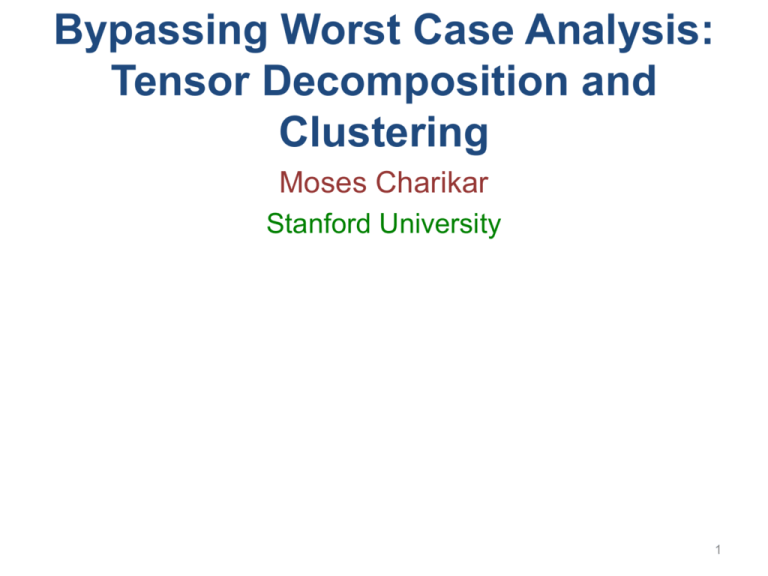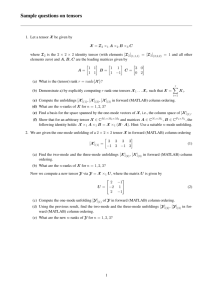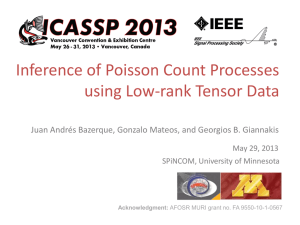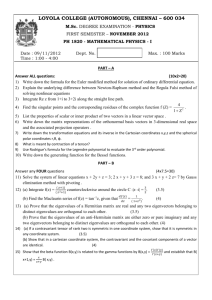slides
advertisement

Bypassing Worst Case Analysis:
Tensor Decomposition and
Clustering
Moses Charikar
Stanford University
1
• Rich theory of analysis of algorithms and
complexity founded on worst case analysis
• Too pessimistic
• Gap between theory and practice
2
Bypassing worst case analysis
• Average case analysis
– unrealistic?
• Smoothed analysis [Spielman, Teng ‘04]
• Semi-random models
– instances come from random + adversarial
process
• Structure in instances
– Parametrized complexity, Assumptions on input
• “Beyond Worst Case Analysis”
course by Tim Roughgarden
3
Two stories
• Convex relaxations for optimization problems
• Tensor Decomposition
Talk plan:
• Flavor of questions and results
• No proofs (or theorems)
4
PART 1:
INTEGRALITY OF CONVEX
RELAXATIONS
5
Relax and Round paradigm
• Optimization over feasible set hard
• Relax feasible set to bigger region
• optimum over relaxation easy
– fractional solution
• Round fractional optimum
– map to solution in feasible set
6
Can relaxations be integral?
• Happens in many interesting cases
– All instances (all vertex solutions integral)
e.g. Matching
– Instances with certain structure
e.g. “stable” instances of Max Cut
[Makarychev, Makarychev, Vijayaraghavan ‘14]
– Random distribution over instances
• Why study convex relaxations:
– not tailored to assumptions on input
– proof of optimality
7
Integrality of convex relaxations
• LP decoding
– decoding LDPC codes via linear programming
– [Feldman, Wainwright, Karger ‘05] + several
followups
• Compressed Sensing
– sparse signal recovery
– [Candes, Romberg, Tao ‘04] [Donoho ‘04] +
many others
• Matrix Completion
– [Recht, Fazel, Parrilo ‘07] [Candes, Recht ‘08]
8
MAP inference via Linear
Programming
• [Komodakis, Paragios ‘08] [Sontag thesis ’10]
• Maximum A Posteriori inference in graphical
models
– side chain prediction, protein design, stereo vision
• various LP relaxations
– pairwise relaxation: integral 88% of the time
– pairwise relaxation + cycle inequalities: 100%
integral
• [Rush, Sontag, Collins, Jaakkola ‘10]
– Natural Language Processing (parsing, part-ofspeech tagging)
9
(Semi)-random graph partitioning
• “planted” graph bisection
p: prob. of edges inside
p
q: prob. of edges across parts
• Goal: recover partition
q
p
• SDP relaxation is exact [Feige, Kilian ’01]
• robust to adversarial additions inside/deletions
across
(also [Makarychev, Makarychev,
Vijayaraghavan ‘12,’14])
10
Thesis
• Integrality of convex relaxations is interesting
phenomenon that we should understand
• Different measure of strength of relaxation
• Going beyond “random instances with
independent entries”
11
(Geometric) Clustering
• Given points in
, divide into k clusters
• Key difference: distance matrix entries not
independent!
• [Elhamifar, Sapiro,
Vidal ‘12]
• integer solutions from
convex relaxation
12
Distribution on inputs [Nellore, Ward ‘14]
• n points drawn randomly from each of k
spheres
(radius 1)
• Minimum separation Δ between centers
• How much separation to guarantee
integrality?
Δ
13
Lloyd’s method can fail
• Multiple copies of 3 cluster configuration:
Ai
Ci
Bi
• Lloyd’s algorithm fails if initialization either
– assigns some group < 3 centers, or
– assigns some group 2 centers in Ci and one in Ai
Bi
• Random initialization (also k-means++) fails
14
k-median
• Given: point set, metric on points
• Goal: Find k centers, assign points to closest
center
• Minimize: sum of distances of points to
centers
15
k-median LP relaxation
zpq: q assigned to center at p
yp: center at p
every q assigned to one center
q assigned to p center at p
exactly k centers
well studied relaxation in
Operations Research and
Theoretical Computer Science
16
k-means
• Given: point set in
• Goal: Partition into k clusters
• Minimize: sum of squared distances to
cluster centroids
• Equivalent objective:
17
k-means LP relaxation
• objective:
0
0
18
k-means LP relaxation
zpq > 0: p and q in cluster of size 1/zpq
yp > 0: p in a cluster of size 1/yp
exactly k clusters
19
k-means SDP relaxation[Peng, Wei, ‘07]
zpq > 0: p and q in cluster of size 1/zpq
zpp = yp > 0: p in a cluster of size 1/yp
exactly k clusters
0
“integer” Z =
0
20
Results
• k-median LP is integral for Δ ≥ 2+ε
– Jain-Vazirani primal-dual algorithm recovers
optimal solution
• k-means LP is integral for Δ > 2+√2
(not integral for Δ < 2+√2)
• k-means SDP is integral for Δ ≥ 2+ ε (d
large)
[Iguchi, Mixon, Peterson, Villar ‘15]
21
Proof Strategy
• Exhibit dual certificate
– lower bound on value of relaxation
– addnl properties: optimal solution of relaxation is
unique
• “Guess” values of dual variables
• Deterministic condition for validity of dual
• Show condition holds for input distribution
22
Failure of k-means LP
p
q
• If there exist p in C1, q in C2
• then k-means LP can “cheat”
23
Rank recovery
• Distribution on inputs with noise
low noise
medium noise
high noise
exact recovery of
optimal solution
planted solution not
optimal, yet convex
relaxation recovers
low rank solution
convex relaxation not
integral; exact
optimization hard?
Rank Recovery
24
Multireference Alignment
[Bandeira, C, Singer, Zhu ‘14]
signal
random rotation
add noise
25
Multireference alignment
• Many independent copies of process: X1, X2,
…, Xn
• Recover original signal (upto rotation)
• If we knew rotations, unrotate and average
• SDP with indicator vectors for every Xi and
possible rotations 0,1,…,d-1
• <vi,r(i) , vj,r(j)> : “probability” that we pick
rotation r(i) for Xi and rotation r(j) for Xj
• SDP objective: maximize sum of dot
products of “unrotated” signals
26
Rank recovery
low noise
medium noise
high noise
exact recovery of
optimal solution
planted solution not
optimal, yet convex
relaxation recovers
low rank solution
convex relaxation not
integral; exact
optimization hard?
Rank Recovery
• Challenge: how to construct dual certificate?
27
Questions / directions
• More general input distributions for clustering?
• Really understand why convex relaxations are
integral
– dual certificate proofs give little intuition
• Integrality of convex relaxations in other
settings?
• Explain rank recovery
• Exact recovery via convex relaxation +
postprocessing?
[Makarychev, Makarychev, Vijayaraghavan ‘15]
28
PART 2: TENSOR
DECOMPOSITION
with Aditya Bhaskara, Ankur Moitra, Aravindan Vijayaraghavan
29
Factor analysis
test scores
movies
Believe: matrix has a “simple explanation”
+
+
(sum of “few”
rank-one factors)
30
Factor analysis
movies
test scores
Believe: matrix has a “simple explanation”
• Sum of “few” rank one matrices (R < n )
• Many decompositions – find a “meaningful” one
(e.g. non-negative, sparse, …) [Spearman 1904]
31
The rotation problem
Any suitable “rotation” of the vectors gives a different decomposition
A
BT
=
A
Q
Q-1
BT
Often difficult to find “desired” decomposition..
32
Tensors
Multi-dimensional arrays
n
n
n
n
n
• Represent higher order correlations, partial derivatives, etc.
• Collection of matrix (or smaller tensor) slices
33
3-way factor analysis
n
• Tensor can be written as a sum of
few rank-one tensors
n
n
• Smallest such R is called the rank
[Kruskal 77]. Under certain rank conditions,
tensor decomposition is unique!
surprising! 3-way decompositions
overcome the rotation problem
34
Applications
Psychometrics, chemometrics, algebraic statistics, …
• Identifiability of parameters in latent variable models
[Allman, Matias, Rhodes 08
[Anandkumar, et al 10-]
Recipe:
1. Compute tensor whose decomposition encodes parameters
(multi-view, topic models, HMMs, ..)
2. Appeal to uniqueness (show that conditions hold)
35
Kruskal rank & uniqueness
A =
…
, B = … , C = … (n x R)
• stronger notion than rank
• reminiscent of restricted isometry
(Kruskal rank). The largest k for which every k-subset of
columns (of A) is linearly independent; denoted KR(A)
[Kruskal 77]. Decomposition [A B C] is unique if it satisfies:
KR(A) + KR(B) + KR(C) ≥ 2R+2
36
Learning via tensor decomposition
Recipe:
1. Compute tensor whose decomposition encodes parameters
(multi-view, topic models, HMMs, ..)
2. Appeal to uniqueness (show that conditions hold)
• Cannot estimate tensor exactly (finite samples)
• Models are not exact!
37
Result I (informal)
A robust uniqueness theorem
[Bhaskara, C, Vijayaraghavan
‘14]
[Kruskal 77]. Given T = [A B C], can recover A,B,C if:
KR(A) + KR(B) + KR(C) ≥ 2R+2
(Robust). Given T = [A B C] + err, can recover A,B,C (up to err’ ) if:
KRτ(A) + KRτ(B) + KRτ(C) ≥ 2R+2
• Err and Err’ are polynomially related (poly(n, τ))
• KRτ(A) robust analog of KR(.) – require every (nxk)-submatrix to
have condition number < τ
• Implies identifiability with polynomially many samples!
38
Identifibility vs. algorithms
(Robust). Given T = [A B C] + err, can recover A,B,C (up to err’ ) if:
KRτ(A) + KRτ(B) + KRτ(C) ≥ 2R+2
both Kruskal’s theorem and
our results “non-constructive”
• Algorithms known only for full rank case: two of A,B,C have rank R
[Jennrich][Harshman 72][Leurgans et al. 93][Anandkumar et
al. 12]
• General tensor decomposition, finding tensor rank, etc. all NP hard
[Hastad 88][Hillar Lim 08]
• Open problem: can Kruskal’s theorem be made algorithmic?
39
ALGORITHMS FOR
TENSOR DECOMPOSITION
40
Generative models for data
Assumption. given data can be “explained” by a
probabilistic generative model with few parameters
(samples from data ~ samples generated from model)
Learning Qn: given many samples from model, find parameters
41
Gaussian mixtures (points)
Parameters:
R gaussians (means)
mixing weights (sum 1) w1, …, wR
To generate a point:
1. pick a gaussian (w.p. wr)
2. sample from
42
Topic models (docs)
Idea: every doc is about a topic, and each topic is a prob.
distribution over words (R topics, n words)
Parameters:
R probability vectors pr
mixing weights w1, …, wR
To generate a doc:
1. pick topic Pr[ topic r ] = wr
2. pick words: Pr[ word j ] = pr(j)
43
Recipe for estimating parameters
step 1. compute a tensor whose decomposition encodes
model parameters
step 2. find decomposition (and hence parameters)
[Allman, Matias, Rhodes]
[Rhodes, Sullivan] [Chang]
“Identifiability”
44
Illustration
• Gaussian mixtures:
– Can estimate the tensor:
– Entry (i,j,k) is obtained from
• Topic models:
– Can estimate the tensor:
Moral: algorithm to decompose tensors => can recover
parameters in mixture models
45
Tensor linear algebra is hard
with power comes intractability
[Hastad ‘90] [Hillar, Lim ‘13]
• Hardness results are worst case
• What can we say about typical instances?
Gaussian mixtures:
Topic models:
• Smoothed analysis [Spielman, Teng ‘04]
46
Smoothed model
Typical Instances
• Component vectors perturbed:
• Input is tensor product of perturbed vectors
• [Anderson, Belkin, Goyal, Rademacher, Voss
‘14]
47
One easy case..
[Harshman 1972] [Jennrich] Decomposition is easy when the
vectors involved are (component wise) linearly independent
[Leurgans, Ross, Abel 93]
[Chang 96]
[Anandkumar, Hsu, Kakade
11]
• If A,B,C are full rank, then can
recover them, given T
A =
…
• in
If A,B,C
are well conditioned,
(unfortunately) holds
many applns..
can recover given T+(noise)
[Stewart, Sun
90]
No hope in the “overcomplete” case (R >> n) (hard
instances)
48
Basic idea
Consider a 6th order tensor with rank R < n2
Trick: view T as an n2 x n2 x n2 object
vectors in the decomposition are:
Question: are these vectors linearly independent?
plausible.. vectors are n2 dimensional
49
Product vectors & linear structure
Q: is the following matrix well
conditioned? (allows robust recovery)
• Vectors in n2 dim space, but
“determined” by vectors in n space
• Inherent “block structure”
Theorem (informal). For any set of vectors {ar, br}, a
perturbation is “good” (for R < n2/4), with probability 1- exp(-n*).
can be generalized to higher order
products.. (implies main thm)
smoothed analysis
50
Proof sketch
Lemma. For any set of vectors {ai, bi}, matrix below (for R < n2/4)
has condition number < poly(n/ρ), with probability 1- exp(-n*).
Issue: perturb before product.. easy if we had
perturbed columns of this matrix
usual results on random
matrices don’t apply
Technical contribution: product of perturbed
vectors behave like random vectors in
51
Proof Strategy
• Every
has large projection
onto space orthogonal to span of the rest
• Problem: Don’t know orthogonal space
• Instead: Show that
has large
projection onto any 3n2/4 dimensional space
52
Result
[Bhaskara, C, Moitra,
Vijayaraghavan ‘14]
Theorem (informal). For higher order(d) tensors, we can typically
compute decompositions for much higher rank (
)
smoothed analysis
Definition. Call parameters
robustly recoverable if we can
recover them (up to ε.poly(n)) given T+(noise), where (noise) is <
ε, and
most parameter settings are
robustly recoverable
Theorem. For any
, and
are robustly recoverable w.p. 1-exp(-nf(d)).
, perturbations
53
Our result for mixture models
Corollary. Given samples from a mixture model (topic model,
Gaussian mixture, HMM, ..), we can “almost always” find the
model parameters in poly time, for any R < poly(n).
observation: we can usually estimate
necessary higher order moments
[Anderson, Belkin, Goyal, Rademacher, VossHere:
‘14]
sample complexity: polyd(n,1/ρ)
polyd(n,1/ρ)
error probability:
poly(1/n)
exp(-n^{1/3d})
54
Questions, directions
• Algorithms for rank > n for 3-tensors?
– can we decompose under Kruskal’s conditions?
– plausible ways to prove hardness?
– [Anandkumar, Ge, Janzamin ‘14] (possible for O(n)
incoherence)
• Dependence on error
– do methods completely fail if error is say constant?
– new promise: SoS semidefinite programming
approaches
[Barak, Kelner, Steurer ‘14]
[Ge, Ma ‘15] [Hopkins, Schramm, Shi, Steurer ‘15]
55
Questions?
56






